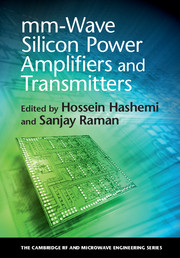Book contents
- Frontmatter
- Contents
- List of Contributors
- Preface
- 1 Introduction
- 2 Characteristics, performance, modeling, and reliability of SiGe HBT technologies for mm-wave power amplifiers
- 3 Characteristics, performance, modeling, and reliability of CMOS technologies for mm-wave power amplifiers
- 4 Linear-mode mm-wave silicon power amplifiers
- 5 Switch-mode mm-wave silicon power amplifiers
- 6 Stacked-transistor mm-wave power amplifiers
- 7 On-chip power-combining techniques for mm-wave silicon power amplifiers
- 8 Outphasing mm-wave silicon transmitters
- 9 Digital mm-wave silicon transmitters
- 10 System-on-a-chip mm-wave silicon transmitters
- 11 Self-healing for silicon-based mm-wave power amplifiers
- Index
- References
10 - System-on-a-chip mm-wave silicon transmitters
Published online by Cambridge University Press: 05 April 2016
- Frontmatter
- Contents
- List of Contributors
- Preface
- 1 Introduction
- 2 Characteristics, performance, modeling, and reliability of SiGe HBT technologies for mm-wave power amplifiers
- 3 Characteristics, performance, modeling, and reliability of CMOS technologies for mm-wave power amplifiers
- 4 Linear-mode mm-wave silicon power amplifiers
- 5 Switch-mode mm-wave silicon power amplifiers
- 6 Stacked-transistor mm-wave power amplifiers
- 7 On-chip power-combining techniques for mm-wave silicon power amplifiers
- 8 Outphasing mm-wave silicon transmitters
- 9 Digital mm-wave silicon transmitters
- 10 System-on-a-chip mm-wave silicon transmitters
- 11 Self-healing for silicon-based mm-wave power amplifiers
- Index
- References
Summary
Introduction
Millimeter-wave (mm-wave) links feature large bandwidths which enable highthroughput, multi-gigabit-per-second (multi-Gb/s) wireless links. High-volume, lowcost applications for wireless communications require the transmitter to achieve a high integration level, avoiding both lossy off-chip interconnects at mm-wave frequencies and expensive packaging technologies. State-of-the-art CMOS [1] and SiGe BiCMOS [2–4] technologies achieve ft and fmax in excess of 200 GHz, making integrated mm-wave circuits feasible (see Fig. 10.1); however, the relatively high operation frequency compared with fmax makes it challenging to achieve both high transmit output power and high efficiency. Earlier chapters have discussed high-efficiency power amplifiers and efficient spatial combining and modulation schemes. This chapter will discuss systemon- a-chip (SOC) approaches to achieve highly integrated mm-wave single-element and phased-array transmitters. It is important to note that mm-wave refers to frequencies from 30 GHz to 300 GHz and the feasibility of several complex transmitter architectures must be evaluated carefully in the context of operating frequency relative to the capabilities of the process technology. The broad range of frequencies also impacts integrated circuit topologies since these frequencies represent a natural yet ill-defined transition point between the use of on-chip lumped inductor/capacitor (LC) passives and on-chip distributed transmission-line (t-line)-based components.
Multi-Gb/s wireless links at mm-wave frequencies
Wireless standards for both short-range links (primarily at 60 GHz) and longer-range point-to-point links (at 40 GHz, 60 GHz, 70–86 GHz, and 94 GHz) have focused on achieving multi-Gb/s data rates. These data rates are substantially higher than those achieved in wireless links at frequencies less than 6 GHz (IEEE 802.11n,WiMax, LTE), an increase primarily achieved by enabling channel bandwidths exceeding 2 GHz (the European standard currently calls for 250-MHz channelization at 80 GHz but allows for channel bonding). The application space for mm-wave wireless links can be broadly divided into (a) short-range wireless local-area network (LAN) links and (b) point-topoint links for high-data-rate wireless backhaul, although proposals exist for the use of mm-wave for next-generation cellular systems [5]. Figure 10.2 summarizes standards for 60-GHz wireless links and licensed E-band (71–76 and 81–86 GHz) wireless links worldwide, demonstrating the large instantaneous bandwidth and wide frequency range that is required of mm-wave transmitter ICs for communications.
- Type
- Chapter
- Information
- mm-Wave Silicon Power Amplifiers and Transmitters , pp. 376 - 418Publisher: Cambridge University PressPrint publication year: 2016



